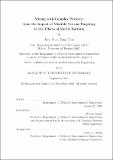| dc.contributor.advisor | Ruben Juanes. | en_US |
| dc.contributor.author | Chui, Jane(Jane Yuen Yung) | en_US |
| dc.contributor.other | Massachusetts Institute of Technology. Department of Civil and Environmental Engineering. | en_US |
| dc.date.accessioned | 2021-01-05T23:15:20Z | |
| dc.date.available | 2021-01-05T23:15:20Z | |
| dc.date.copyright | 2020 | en_US |
| dc.date.issued | 2020 | en_US |
| dc.identifier.uri | https://hdl.handle.net/1721.1/129048 | |
| dc.description | Thesis: Ph. D., Massachusetts Institute of Technology, Department of Civil and Environmental Engineering, September, 2020 | en_US |
| dc.description | Cataloged from student-submitted PDF of thesis. | en_US |
| dc.description | Includes bibliographical references (pages 131-149). | en_US |
| dc.description.abstract | Flow instabilities arising from differences in temperature, density, or viscosity are commonplace. Viscous fingering is a hydrodynamic instability that occurs when a less viscous fluid displaces a more viscous one. Instead of progressing as a uniform front, the displacing fluid forms fingers that vary in size and shape to form complex patterns. The interface created from these patterns affects mixing between the two fluids, and therefore understanding how these patterns evolve in time is essential in applications such as enhanced oil recovery, bioremediation, and microfluidics. In this Thesis, we experimentally quantify the impact miscible viscous fingering has on mixing. We use a radial Hele-Shaw cell as an analog of radial flows in porous media, and high-resolution fluorescent imaging, to measure the temporal and spatial evolution of the mixing zone. We identify distinct regimes in both the interface length and average thickness of the mixing zone. | en_US |
| dc.description.abstract | We use these results to propose a scaling framework for the growth of the mixing zone, and identify for the first time the competing factors of time-dependent dispersion and fluid-interface stretching from viscous fingering. Although bacteria can be found virtually everywhere viscous fingering occurs, there are no studies on the effects of their presence on the displacement dynamics. In this Thesis, we seek to begin filling this knowledge gap by employing as invading fluid an active suspension of fluorescent motile E. coli, and observing how bacterial motility affects the interface and mixing zone between the two fluids. We start by characterizing how viscous environments affect the rheology of these dense suspensions capable of collective swimming (and therefore effective viscosity reductions) using a Couette rheometer. | en_US |
| dc.description.abstract | Remarkably, we find that for the entire range of solvent viscosities tested (1 to 17 mPa · s), we recover superfluidic regimes, in which the effective suspension viscosity is reduced to near-zero values through collective swimming. We use these experimental results to formulate a constitutive model for the rheology of bacterial superfluids under flow as a function of the bacterial concentration and the solvent viscosity. To visualize the motile bacteria both individually and collectively under viscous fingering conditions, we design and fabricate a mesofluidic Hele-Shaw cell that is large enough to accommodate viscous fingering instabilities and small enough to be used with fluorescent microscopy. Surprisingly, we observe a textured interface between the two fluids, in addition to the larger-scale viscous fingering pattern. | en_US |
| dc.description.abstract | This interface consists of four distinct regions: a monodisperse region near the core of the finger, a filamentous region where bacteria segregate into separate flow paths in the direction of finger movement, a "rafting" region where bacteria aggregate into small groups (or "rafts") near the tip of the finger that then get pushed to the sides of the finger, and a diffuse region where the bacteria organize into a diffuse band at the very edge of the interface. These unexpected observations are a first step towards understanding how the interplay between active suspensions of motile bacteria and fluid-mechanical instabilities, such as viscous fingering, affects overall mixing under these complex flow conditions which are found in both natural and engineered environments. | en_US |
| dc.description.statementofresponsibility | by Jane Yuen Yung Chui. | en_US |
| dc.format.extent | 149 pages | en_US |
| dc.language.iso | eng | en_US |
| dc.publisher | Massachusetts Institute of Technology | en_US |
| dc.rights | MIT theses may be protected by copyright. Please reuse MIT thesis content according to the MIT Libraries Permissions Policy, which is available through the URL provided. | en_US |
| dc.rights.uri | http://dspace.mit.edu/handle/1721.1/7582 | en_US |
| dc.subject | Civil and Environmental Engineering. | en_US |
| dc.title | Mixing with complex patterns : from the impact of miscible viscous fingering to the effects of motile bacteria | en_US |
| dc.type | Thesis | en_US |
| dc.description.degree | Ph. D. | en_US |
| dc.contributor.department | Massachusetts Institute of Technology. Department of Civil and Environmental Engineering | en_US |
| dc.identifier.oclc | 1227045962 | en_US |
| dc.description.collection | Ph.D. Massachusetts Institute of Technology, Department of Civil and Environmental Engineering | en_US |
| dspace.imported | 2021-01-05T23:15:19Z | en_US |
| mit.thesis.degree | Doctoral | en_US |
| mit.thesis.department | CivEng | en_US |
